I couple of months back I started a weekly blog called Foam Dart Goodness where I've been posting an assortment of mod guides. While they're all well and good over there, getting them in front of more people to help more people is what I'm aiming for. Towards that end I'll be posting a few here as I go.
Today I've gone a little further than that, OzNerf is getting my latest post before it goes live on Foam Dart Goodness. Hope you enjoy!
_________________________________________________________________
The Nerf Baricade, first released in 2010, it's one of the few flywheel blasters in Nerf's lineup. My first real foray into the world of blasters was pretty heavily based around the BuzzBee Tommy20, so I'm relatively fond of a good old set of flywheels. I know they aren't as efficient as most other types of blasters, they make a lot of noise and take a little while to spin up, but they're still good fun.
I first picked up a pair of Barricades last year after a group I play with decided to have a day of dart tag games. I needed something that would fire taggers and the Barricade seemed like an easy option (the Dart Tag series of blasters still hasn't been released in Australia yet, scheduled this year). Throwing in a few Trustfire AA's quickly upped the voltage and away I went. The day as a whole went pretty well, the Barricades mostly functioning as intended. Only problems were when darts got jammed but the barrel still rotated, they were a pain to get out; and that the jam door sometimes fell ajar, meaning the flywheels would turn off. During the day I also found myself having the remove the batteries and check how much juice they had left with a multimeter. While significantly better than going flat mid game, still rather time consuming and somewhat annoying. All of these problems I've since rectified on this blaster.
________________________________________________________________________
Tools/Materials needed
Screwdrivers (flat and phillips heads)
3 x Trustfire batteries
Digital voltmeter
Soldering iron and solder
Electrical tape
Wire cutters/strippers
Dremel with cutting tool
________________________________________________________________________
We'll kick off with the blaster itself.
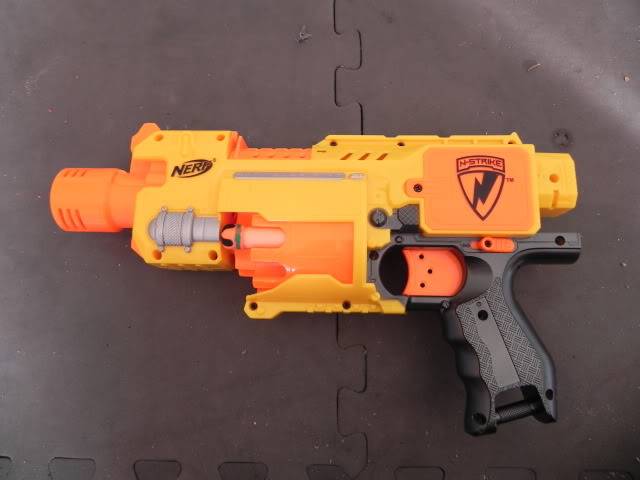
Start by removing the battery cover.
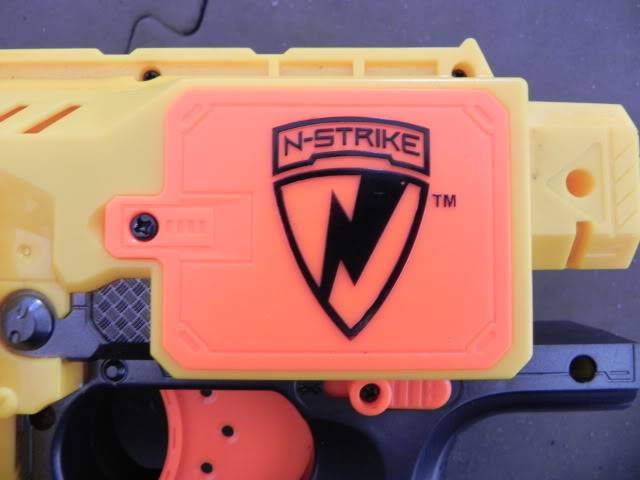
In this case I'm using 3 Trustfire AA's.
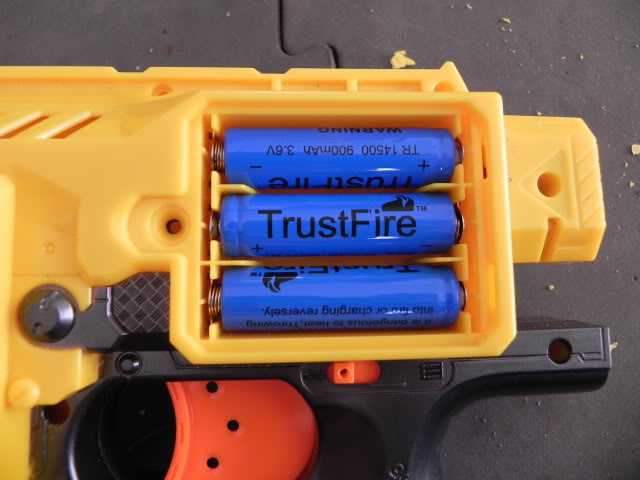
We'll need to remove them too.
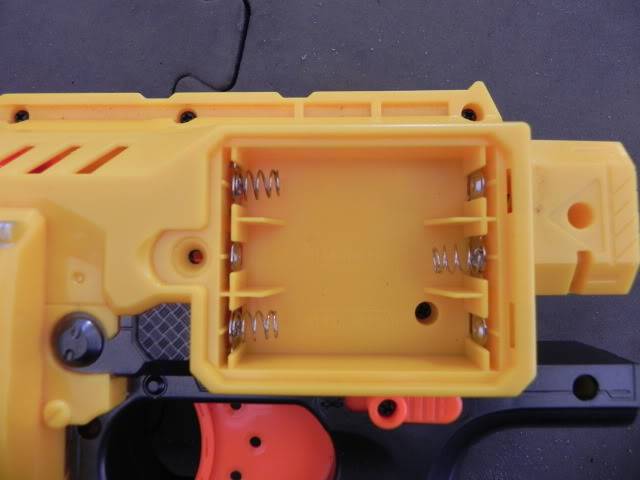
Then the external part of the on/off switch.
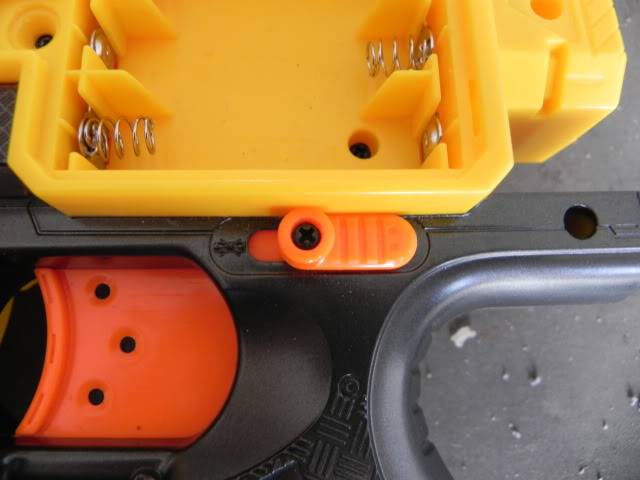
Like so.
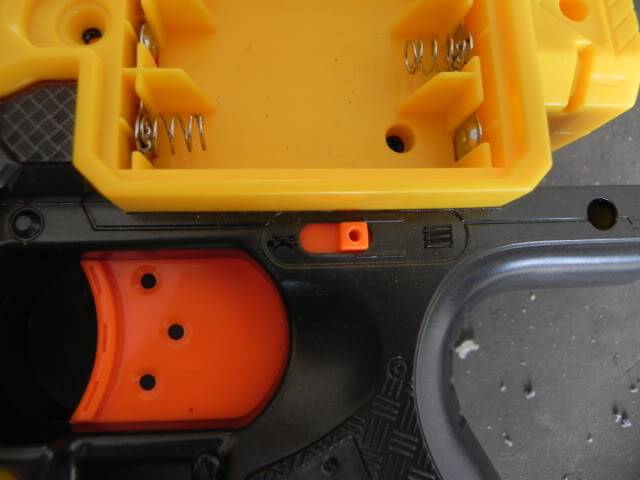
Then remove all of the screws holding the two halves of the shell together. There should be about 15 screws. Because the switch and battery compartment is on the left side of the shell and there obviously needs to be wires between the two, we have to keep the two halves close by.
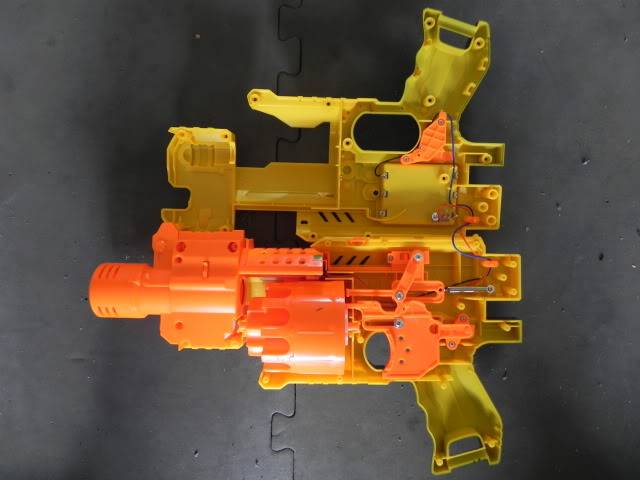
As always, take a moment to familiarise yourself with the insides and try to get an understanding of how it works.

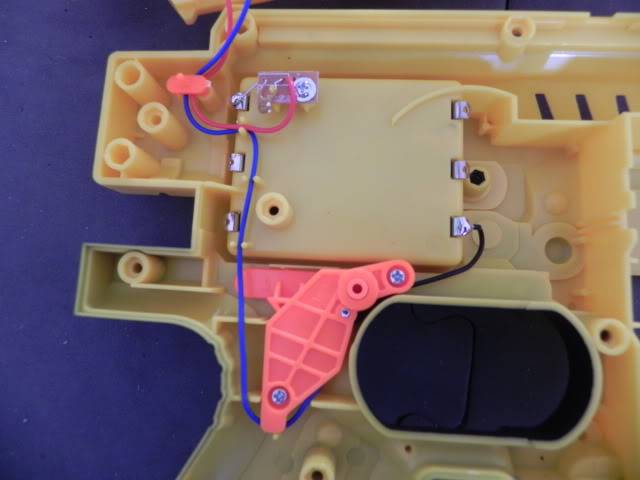

Happy? Good.
Next step is to remove the rotating barrel. We'll need to lift the front end up first, then pull the barrel out towards the front of the blaster.
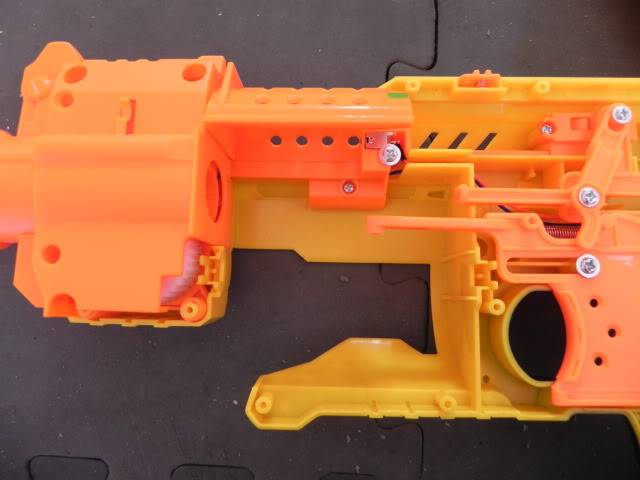
Then remove these two screws.
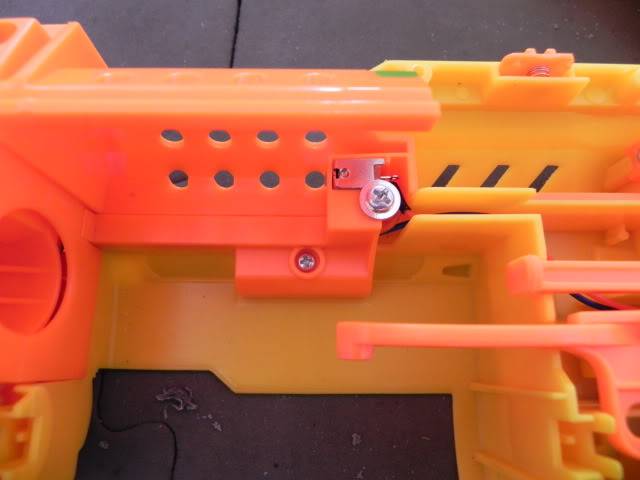
Like so.

We'll now be able to remove the whole front section of the blaster. This is where the flywheels are located
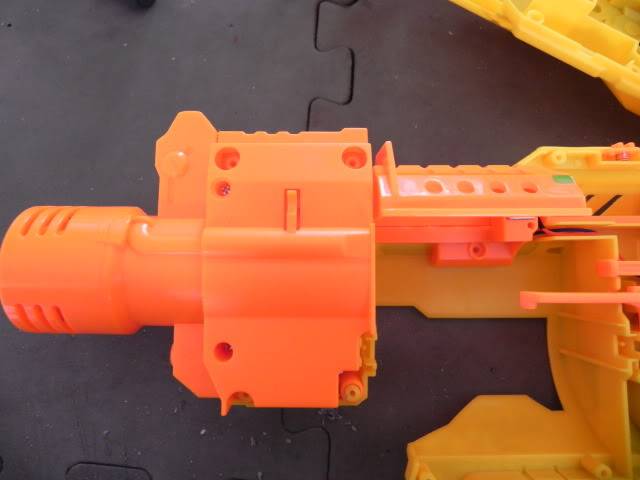
Like so.
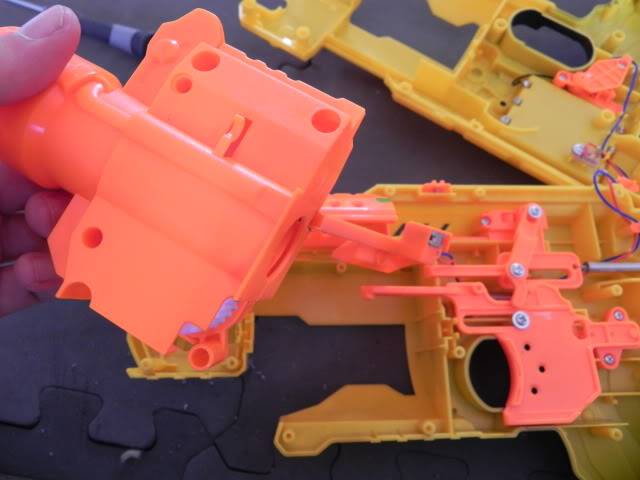
The wires for the flywheels are kept safe under this cover. The small black thing poking up here is a microswitch that checks if the jam door is closed; if it isn't triggered, the flywheels won't turn. Since I was having troubles with the jam door popping slightly ajar of it's own accord, I decided to remove this safety.

Here you can see the switch from the back.
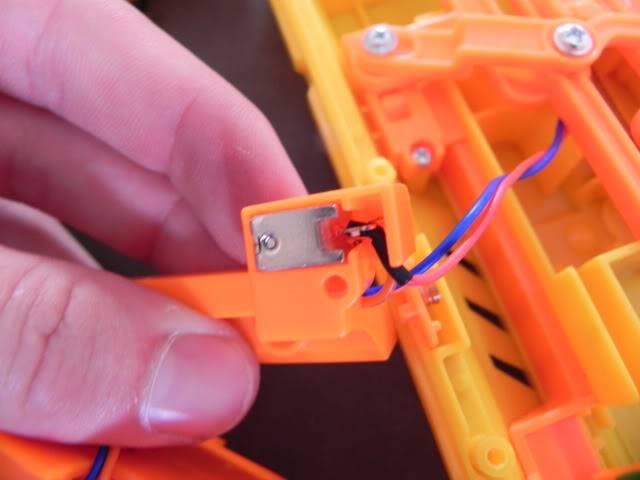
Pry it out with your screwdriver.
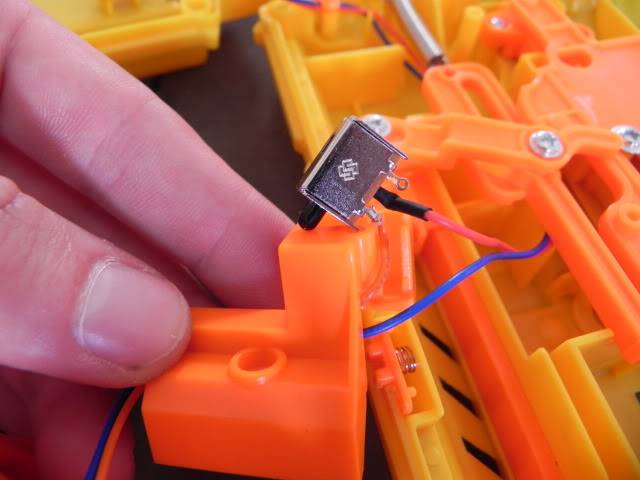
Then we'll need to remove this cover that hold the wires in place.
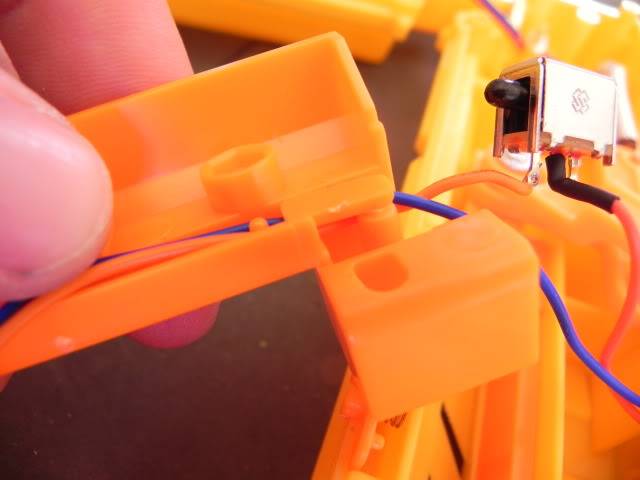
Pry it part way with your screwdriver.

Then just pull it off by hand.
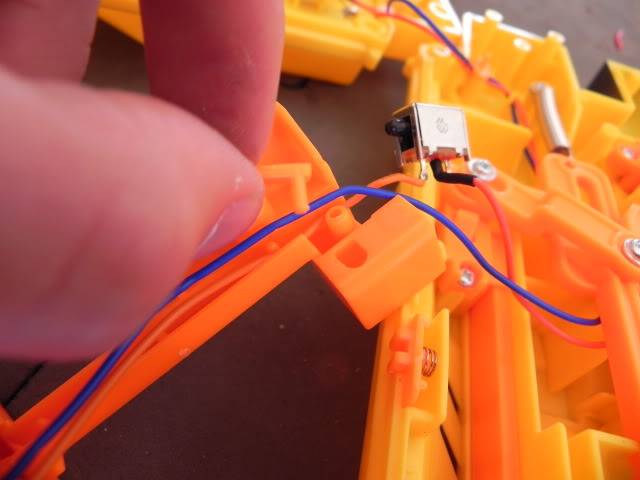
Tada! One mircoswitch, free from it's original housing. It's a very simple circuit that only lets power flow from the red wire (from the battery) to the orange wire (going to the flywheels) when the button is depressed.
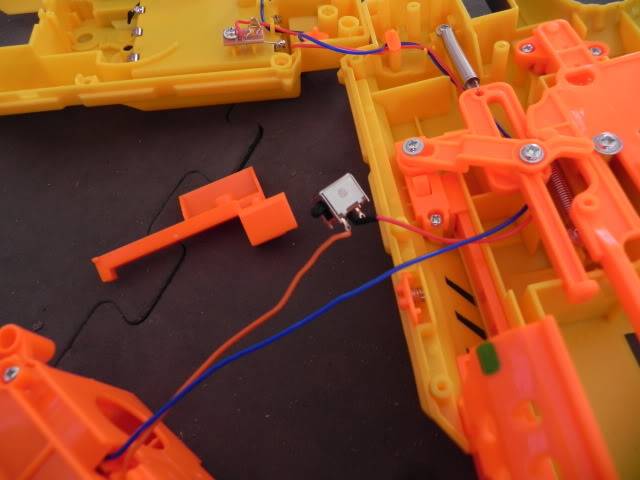
We want that connection to be on all the time, so simply cut the switch out.

Strip back a little of the covering from each wire.
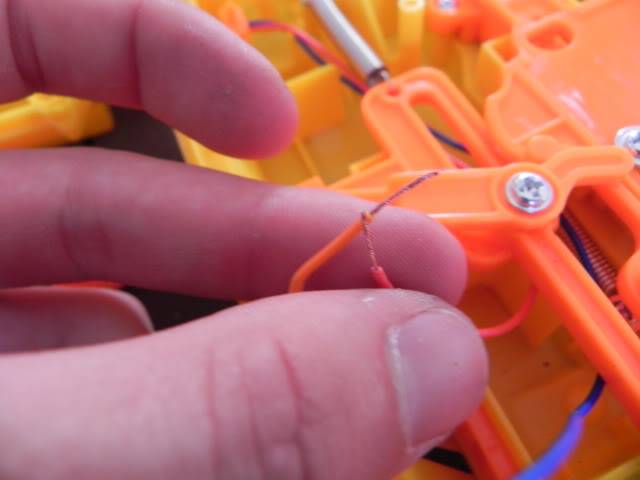
Twist them together.

Then solder the join.
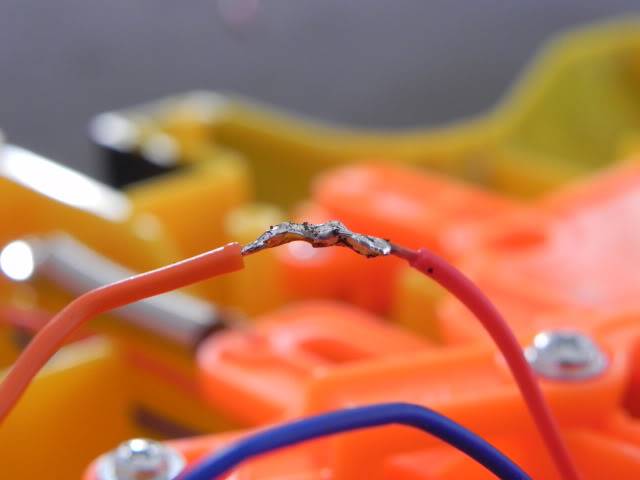
Then protect the join with some tape.
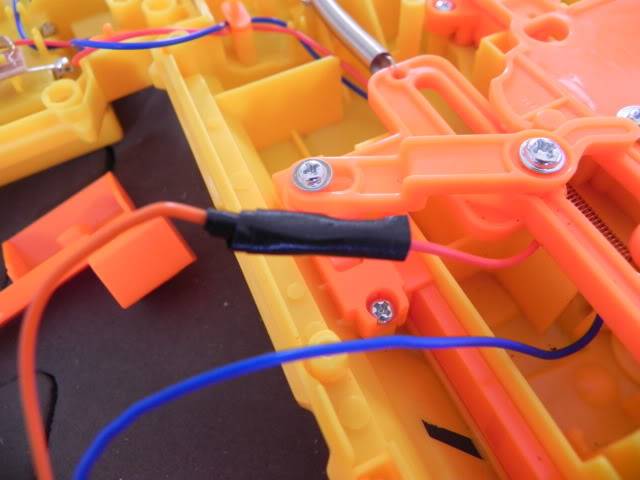
Now we'll move to the back half of the jam door mechanism. Start by removing these two screws and the arm they're securing. This arm is what actuates the dart pusher.
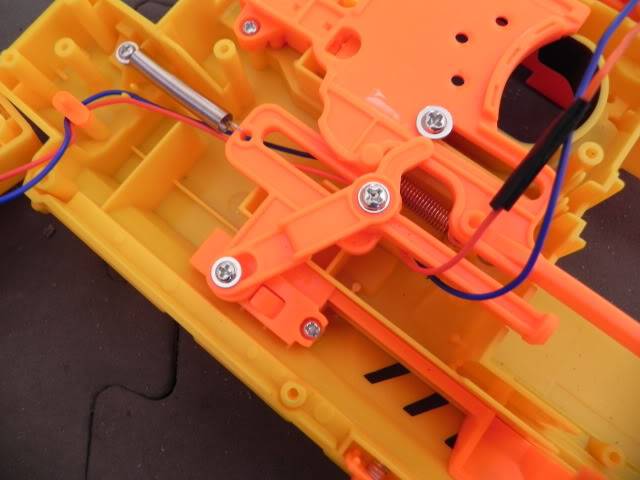
Then remove the dart pusher itself.
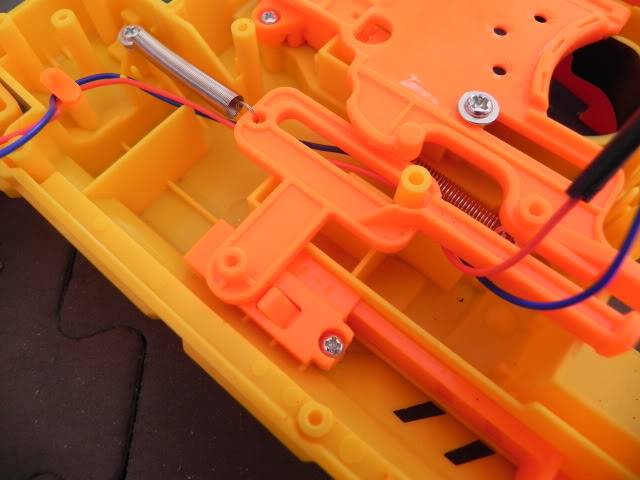
Then these two screws holding the jam door slider in place.
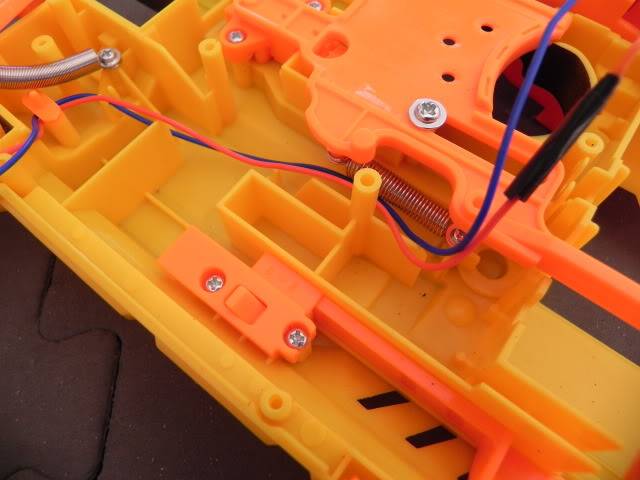
Remove this little chock.
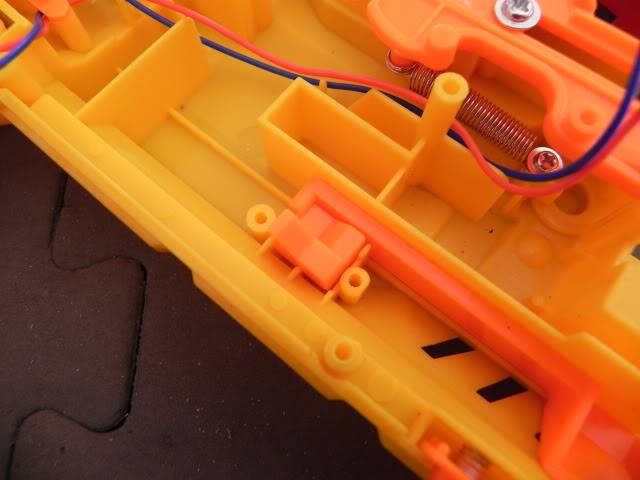
And we should end up like this.
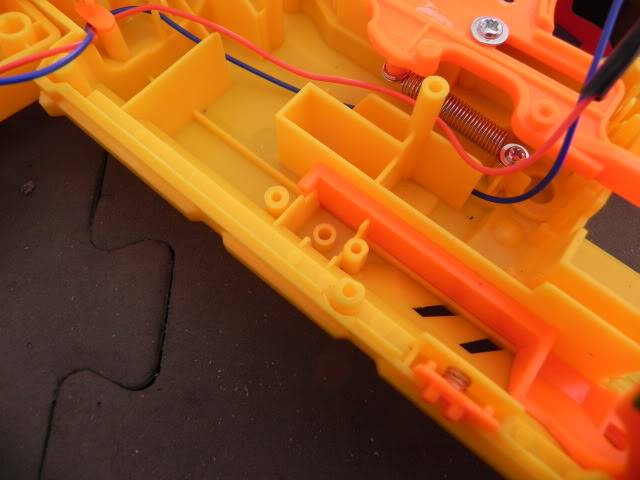
Move back to the middle of the blaster and remove the jam door itself.
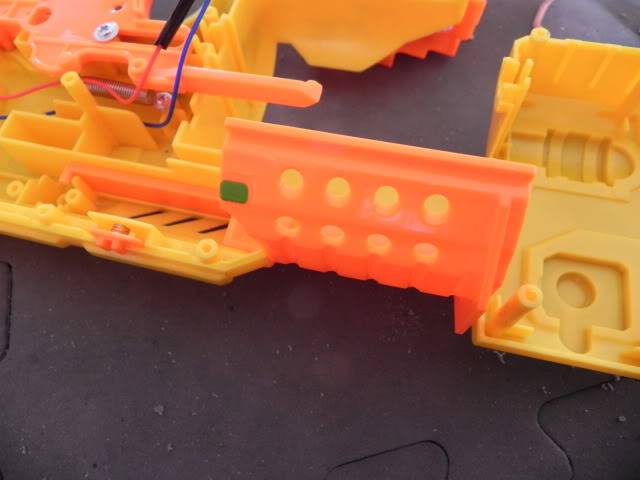
Like so.

Now I don't actually have a photo of the correct way of doing this so I'll have to explain. See how the wires are on the trigger side of that post? Don't do that. Move them to the other side of that post. They will get in the way if you leave them as I've pictured.
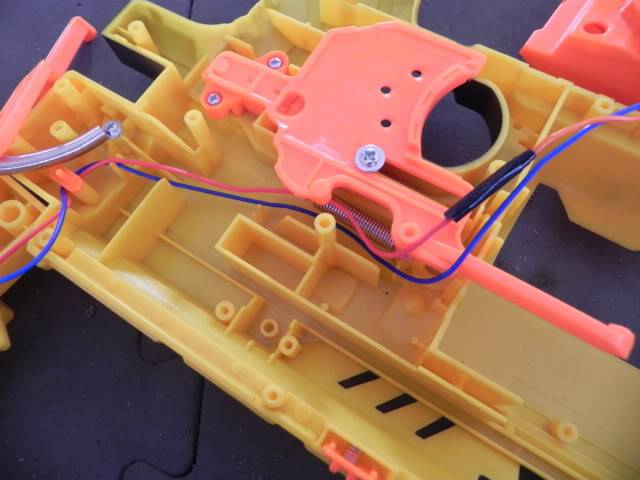
Put the dart pusher back in.
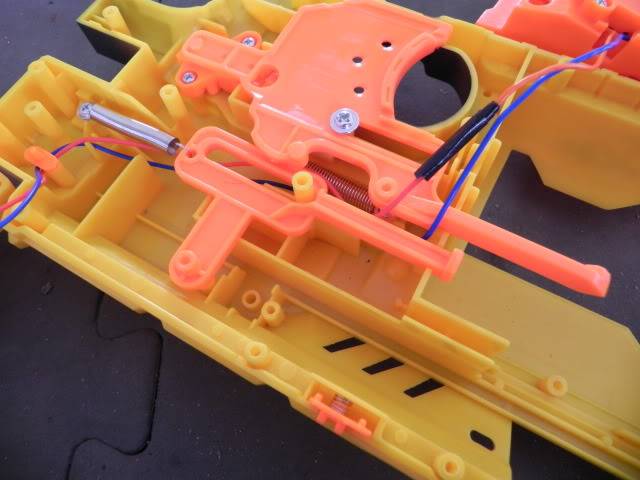
Then the dart pusher arm.

Then the two screws securing it all.
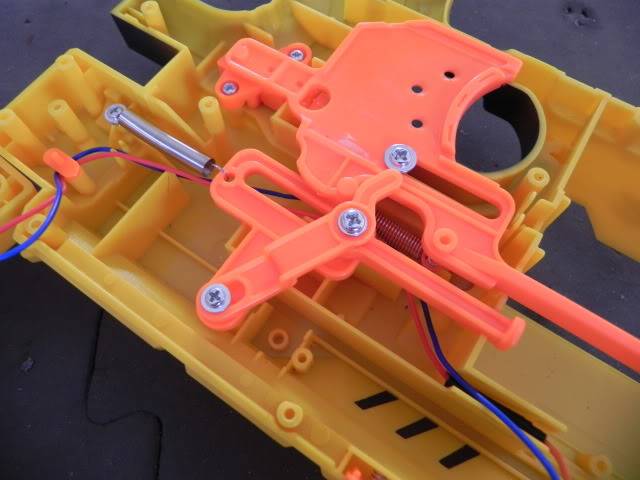
Move back to the front of the blaster.
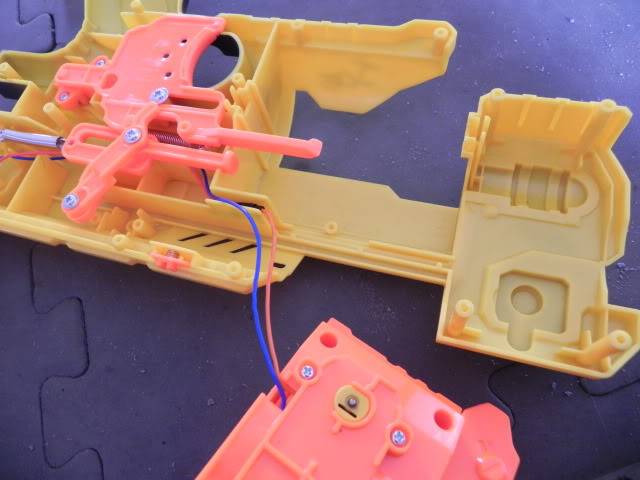
Run the wires back through their protective cover.
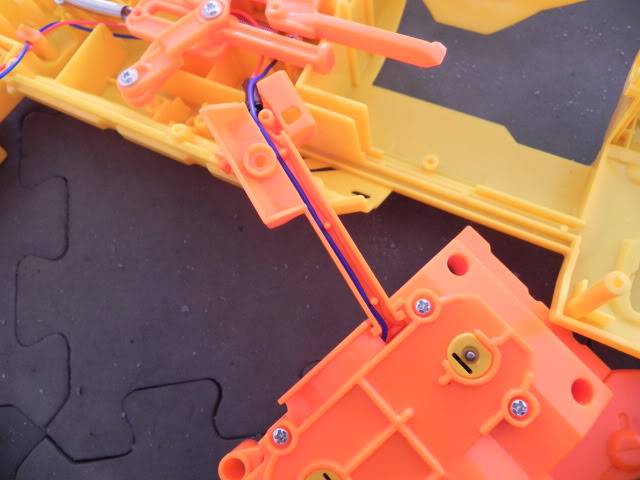
Then re-seat the whole front mechanism.
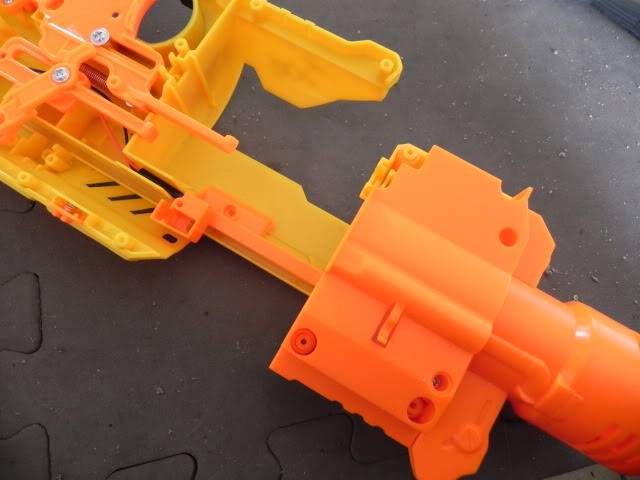
Same shot, from another angle.
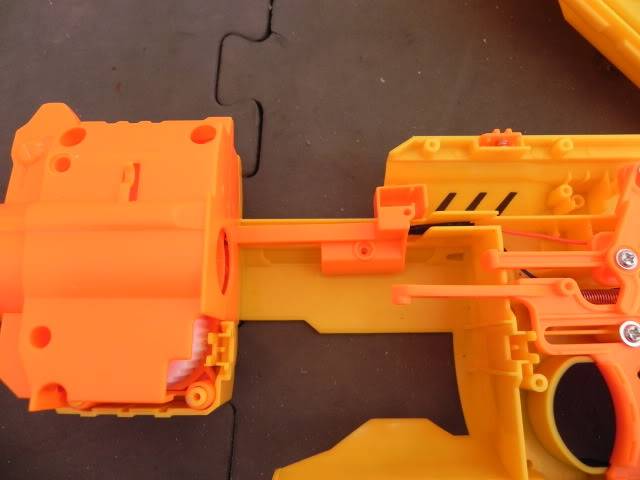
Screw the protective cover back in place. Except, because we've removed the switch, we now only need the bottom screw.
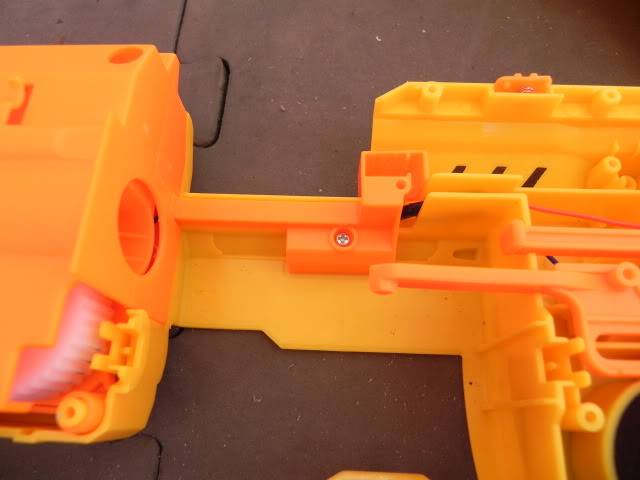
All right, safety removal done! Now we'll move on to the digital voltmeter install. I decided to put mine at the back of the blaster, since that's where it fit best.
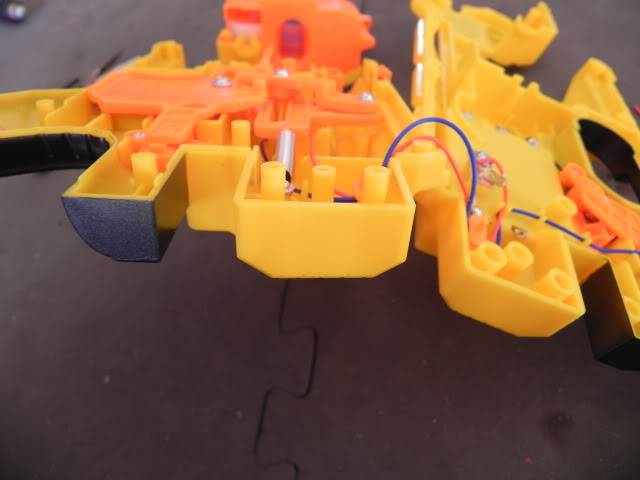
Here's the component itself. The one I've sourced has three wires; brown is negative, red is positive, and yellow is the trigger source (the voltage it's actually measuring). It can be powered off anything from 5-25v, but can measure up to 99v. Because I know my barricade will never run more than 25v, I can wire the yellow and red wires to the same power source.
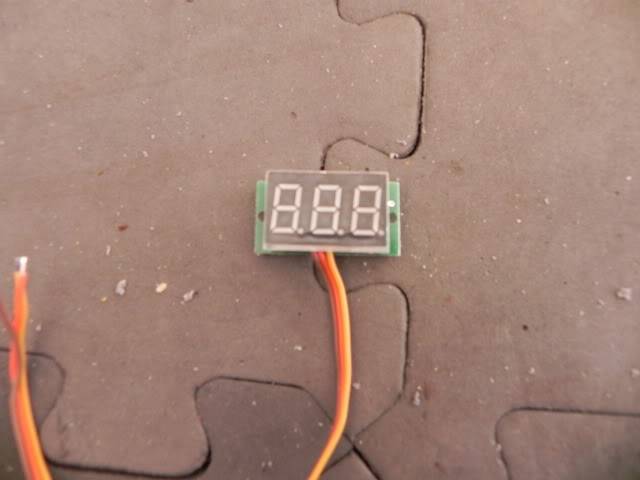
Start by marking out where it will go.

Like so.
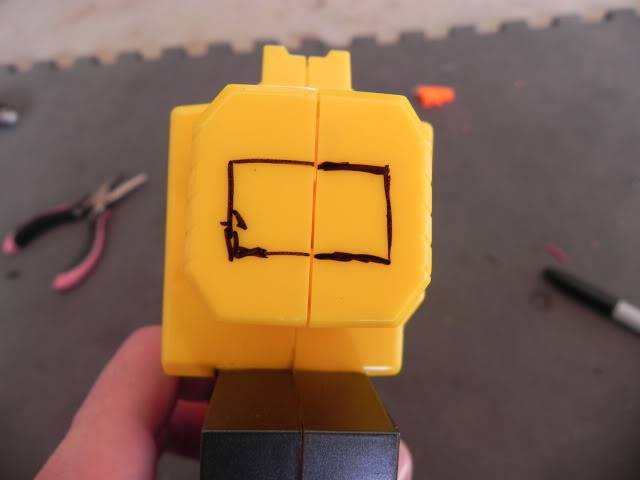
Then grab your dremel and get cutting.
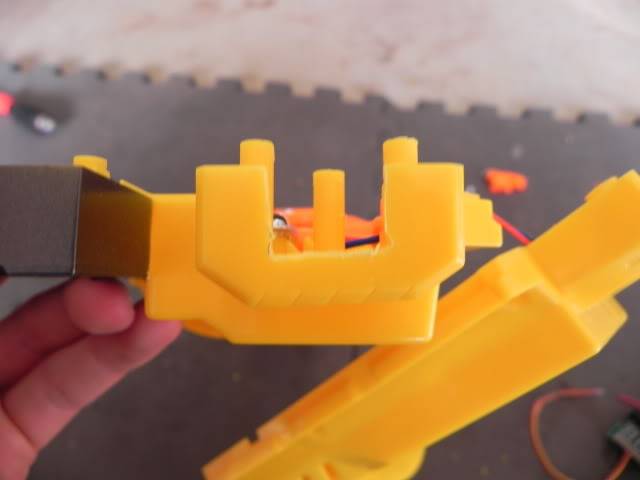
Then do the other side.

Test fit!

In addition to the hole in the external shell, I also had to remove part of the post on the right so that the wiring would fit.

Next, strip back a little of the wiring from the two power wires (red being positive and blue negative).
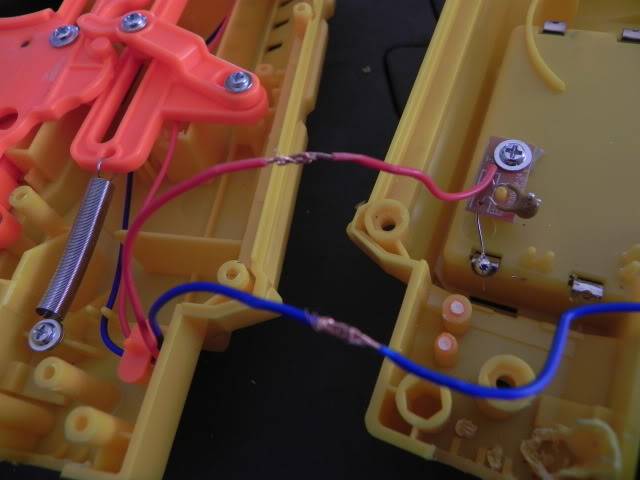
Connect the wires from the voltmeter.
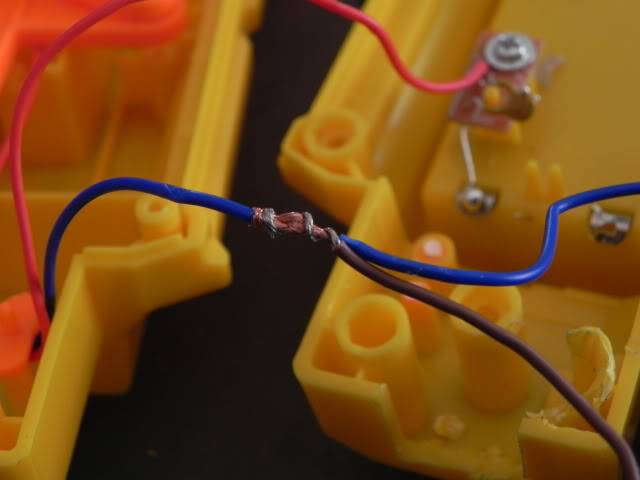
Solder!
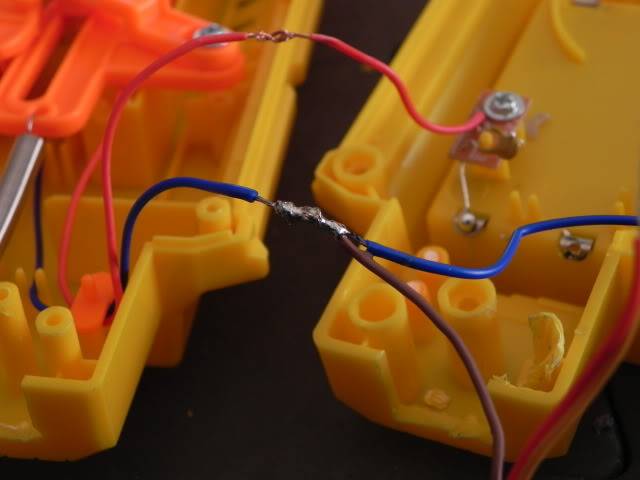
Then tape.
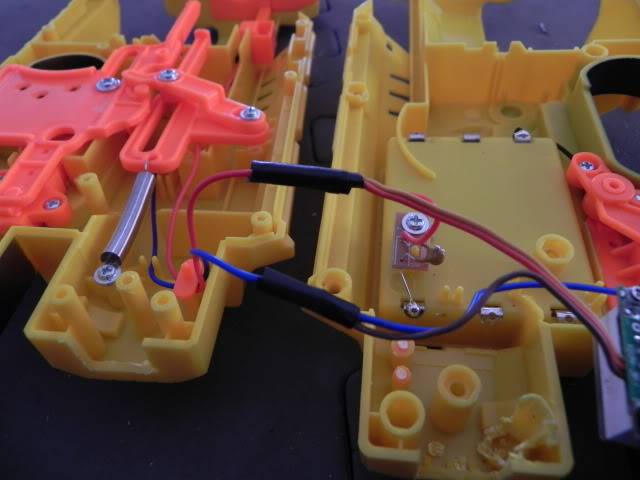
Throw some batteries in it, flick the switch and check if the voltmeter works.

Apparently I forgot to take a photo of this next step but it's really quite simple. Glue it in place.
Go back to the other half of the shell.
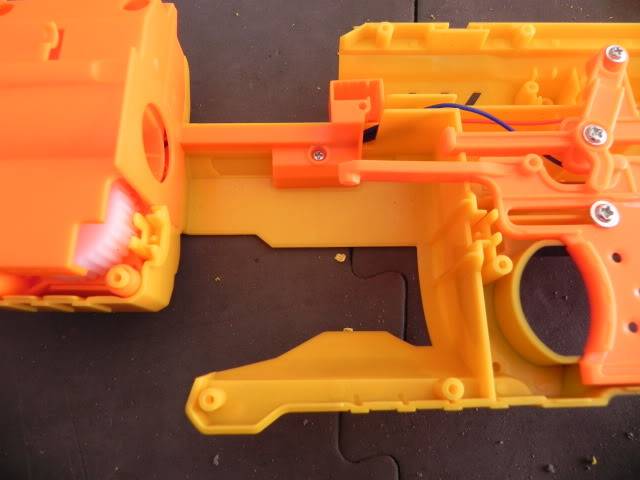
Put the barrel back in. Reinsertion is the opposite of removal; feed from the front, seat the back first, then the front.

Put the shell back together, then put the outer half of the power switch back on.

There you have it. One Barricade, sans jam door, with inbuilt voltmeter. Below is how it looks with the blaster switched off.

Then, with the blaster switched on.
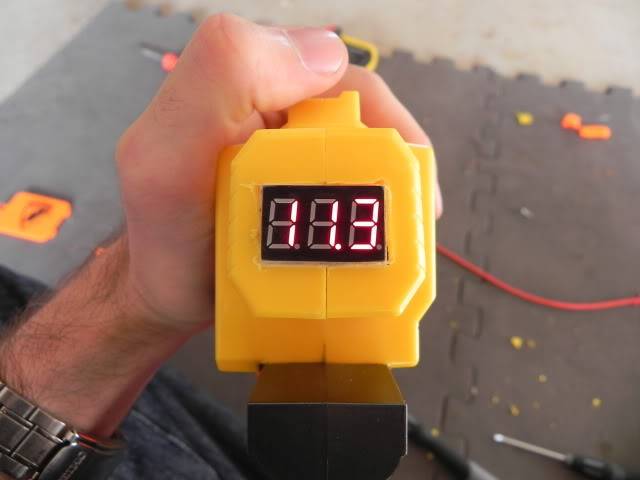
Now while most would say the voltmeter is really just there for showing off, which it admittedly is a little, it does still serve quite a useful purpose. There is now absolutely no guess work involved in "are my batteries going flat or am I just imagining I'm getting less range than before?", it simply tells you, right there mid game.
Unfortunately I upped the voltage so long ago now that I couldn't tell you what the stock range of a Barricade is. However, with taggers this one is hitting around the 17m mark.
Today I've gone a little further than that, OzNerf is getting my latest post before it goes live on Foam Dart Goodness. Hope you enjoy!
_________________________________________________________________
The Nerf Baricade, first released in 2010, it's one of the few flywheel blasters in Nerf's lineup. My first real foray into the world of blasters was pretty heavily based around the BuzzBee Tommy20, so I'm relatively fond of a good old set of flywheels. I know they aren't as efficient as most other types of blasters, they make a lot of noise and take a little while to spin up, but they're still good fun.
I first picked up a pair of Barricades last year after a group I play with decided to have a day of dart tag games. I needed something that would fire taggers and the Barricade seemed like an easy option (the Dart Tag series of blasters still hasn't been released in Australia yet, scheduled this year). Throwing in a few Trustfire AA's quickly upped the voltage and away I went. The day as a whole went pretty well, the Barricades mostly functioning as intended. Only problems were when darts got jammed but the barrel still rotated, they were a pain to get out; and that the jam door sometimes fell ajar, meaning the flywheels would turn off. During the day I also found myself having the remove the batteries and check how much juice they had left with a multimeter. While significantly better than going flat mid game, still rather time consuming and somewhat annoying. All of these problems I've since rectified on this blaster.
________________________________________________________________________
Tools/Materials needed
Screwdrivers (flat and phillips heads)
3 x Trustfire batteries
Digital voltmeter
Soldering iron and solder
Electrical tape
Wire cutters/strippers
Dremel with cutting tool
________________________________________________________________________
We'll kick off with the blaster itself.

Start by removing the battery cover.

In this case I'm using 3 Trustfire AA's.

We'll need to remove them too.

Then the external part of the on/off switch.

Like so.

Then remove all of the screws holding the two halves of the shell together. There should be about 15 screws. Because the switch and battery compartment is on the left side of the shell and there obviously needs to be wires between the two, we have to keep the two halves close by.

As always, take a moment to familiarise yourself with the insides and try to get an understanding of how it works.



Happy? Good.
Next step is to remove the rotating barrel. We'll need to lift the front end up first, then pull the barrel out towards the front of the blaster.

Then remove these two screws.

Like so.

We'll now be able to remove the whole front section of the blaster. This is where the flywheels are located

Like so.

The wires for the flywheels are kept safe under this cover. The small black thing poking up here is a microswitch that checks if the jam door is closed; if it isn't triggered, the flywheels won't turn. Since I was having troubles with the jam door popping slightly ajar of it's own accord, I decided to remove this safety.

Here you can see the switch from the back.

Pry it out with your screwdriver.

Then we'll need to remove this cover that hold the wires in place.

Pry it part way with your screwdriver.

Then just pull it off by hand.

Tada! One mircoswitch, free from it's original housing. It's a very simple circuit that only lets power flow from the red wire (from the battery) to the orange wire (going to the flywheels) when the button is depressed.

We want that connection to be on all the time, so simply cut the switch out.

Strip back a little of the covering from each wire.

Twist them together.

Then solder the join.

Then protect the join with some tape.

Now we'll move to the back half of the jam door mechanism. Start by removing these two screws and the arm they're securing. This arm is what actuates the dart pusher.

Then remove the dart pusher itself.

Then these two screws holding the jam door slider in place.

Remove this little chock.

And we should end up like this.

Move back to the middle of the blaster and remove the jam door itself.

Like so.

Now I don't actually have a photo of the correct way of doing this so I'll have to explain. See how the wires are on the trigger side of that post? Don't do that. Move them to the other side of that post. They will get in the way if you leave them as I've pictured.

Put the dart pusher back in.

Then the dart pusher arm.

Then the two screws securing it all.

Move back to the front of the blaster.

Run the wires back through their protective cover.

Then re-seat the whole front mechanism.

Same shot, from another angle.

Screw the protective cover back in place. Except, because we've removed the switch, we now only need the bottom screw.

All right, safety removal done! Now we'll move on to the digital voltmeter install. I decided to put mine at the back of the blaster, since that's where it fit best.

Here's the component itself. The one I've sourced has three wires; brown is negative, red is positive, and yellow is the trigger source (the voltage it's actually measuring). It can be powered off anything from 5-25v, but can measure up to 99v. Because I know my barricade will never run more than 25v, I can wire the yellow and red wires to the same power source.

Start by marking out where it will go.

Like so.

Then grab your dremel and get cutting.

Then do the other side.

Test fit!

In addition to the hole in the external shell, I also had to remove part of the post on the right so that the wiring would fit.

Next, strip back a little of the wiring from the two power wires (red being positive and blue negative).

Connect the wires from the voltmeter.

Solder!

Then tape.

Throw some batteries in it, flick the switch and check if the voltmeter works.

Apparently I forgot to take a photo of this next step but it's really quite simple. Glue it in place.
Go back to the other half of the shell.

Put the barrel back in. Reinsertion is the opposite of removal; feed from the front, seat the back first, then the front.

Put the shell back together, then put the outer half of the power switch back on.

There you have it. One Barricade, sans jam door, with inbuilt voltmeter. Below is how it looks with the blaster switched off.

Then, with the blaster switched on.

Now while most would say the voltmeter is really just there for showing off, which it admittedly is a little, it does still serve quite a useful purpose. There is now absolutely no guess work involved in "are my batteries going flat or am I just imagining I'm getting less range than before?", it simply tells you, right there mid game.
Unfortunately I upped the voltage so long ago now that I couldn't tell you what the stock range of a Barricade is. However, with taggers this one is hitting around the 17m mark.



